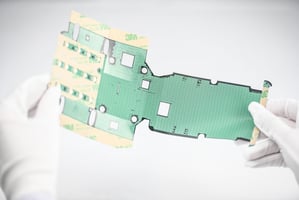Due to economies of scale, large companies almost always have a cost advantage over...
How To Choose The Right Substrate Materials?
Central Midori’s core expertise is in graphic and functional printing on thin and flexible materials. Today’s topic is about how to choose the right substrate materials.
Part 1 is about how to select the proper substrate for your printed electronics application. Part 2 will be about the most commonly used substrates at Central Midori.
How to select the proper substrate
When considering a substrate several characteristics should be in your mind:
-
Physical properties,
-
Electrical properties
-
Thermal properties
-
Chemical resistance
-
Optical characteristics
-
Flammability
-
Toxicity and recycling
Physical Properties
The physical properties will determine the amount of mechanical stress to be applied to the film such as bending, stretching, folding, creasing either static or dynamic independently from the type of printed inks.
Electrical Properties
By nature our substrate is a dielectric and the dielectric strength best characterizes the ability of the material to act as an insulator while its dielectric constant affects its performance as a printed antenna.
Thermal Properties
The Glass Transition Temperature (Tg) is one of the most important properties as it defines the temperature where the material transitions from hard to soft. It is important to comply with the conditions of the customer’s application but also to withstand the conditions of our manufacturing processes.
As far as the dimensional stability, it measures the degree to which a film changes its original size when exposed to temperature. At CMI, to guarantee a very high dimensions stability we instituted a preliminary annealing process where we subject the material to heat prior to printing.
Chemical Resistance
Chemical resistance is often overlooked in the customer’s specifications. Many of our products are employed in Human Machine Interface (HMI) where cleaning is paramount to keep machine operators, medical personnel or consumers, safe. Substances to be tested include oil, acetone, alcohol, bleach and all types of detergent.
Optical Characteristics
Many of our graphic products have optical windows and light transmission and infraction index can be very important to us.
Flammability
The Underwriters Laboratories, also called UL, is an independent global safety science company that tests, verifies, certifies and trains customers on compliance and regulatory issues.
UL-94 is the Standard for Tests for Flammability of Plastic Materials for Parts in Devices and Appliances.
Toxicity and Recycling
A few years ago CMI started to collect and recycle our plastic films and reclaim silver from our functional inks. We consider ourselves a green additive technology and follow scrupulously the recommendations of the Material Safety Data Sheet (MSDS)
Hope this short post helps you determine how to choose the right substrate materials. Please share your thoughts or questions in the comments!
-1.jpg?width=146&height=50&name=Kusu%20(1)-1.jpg)




